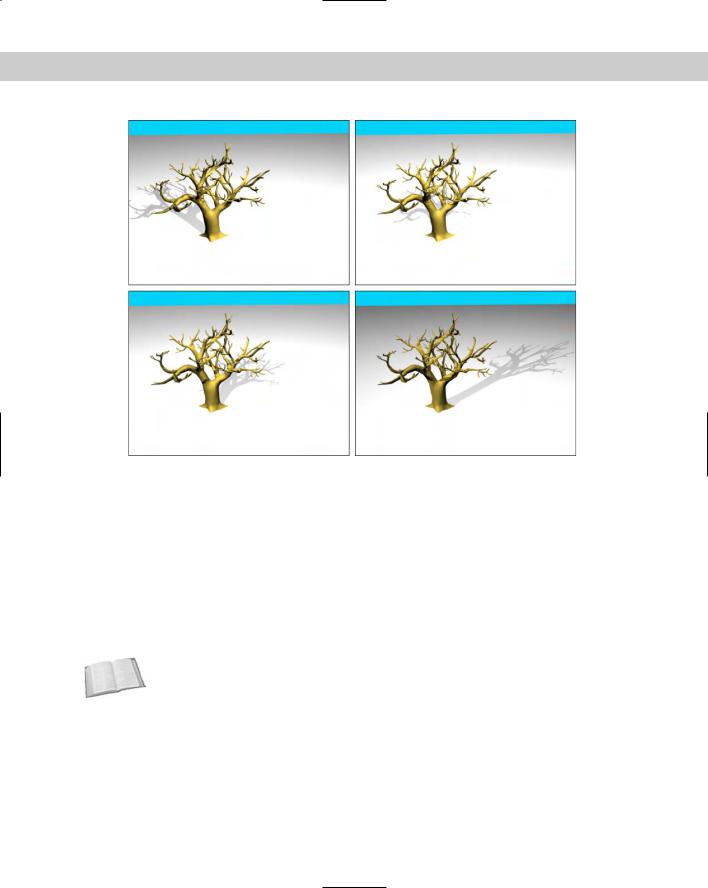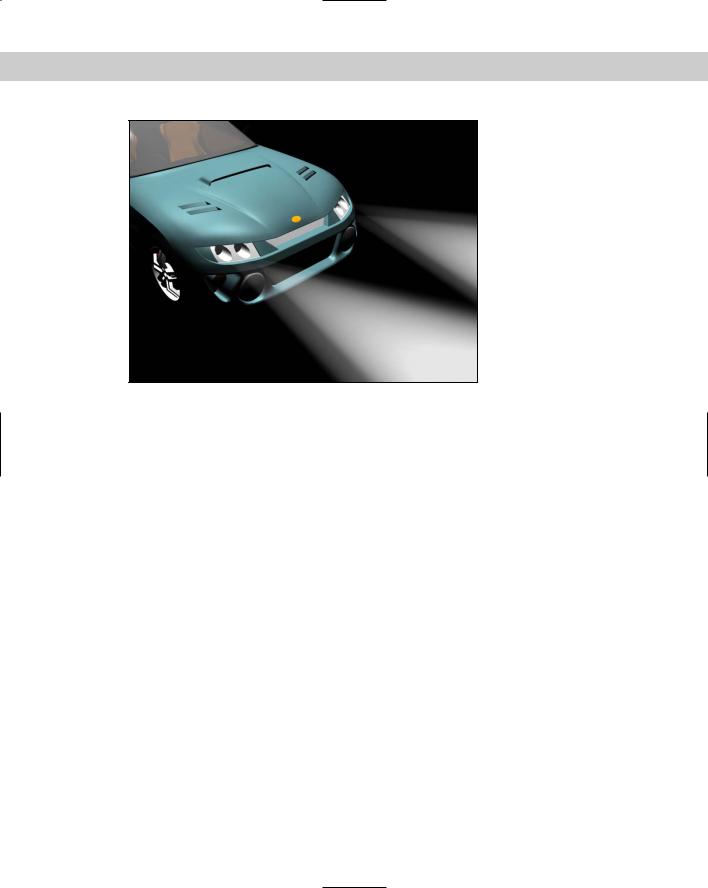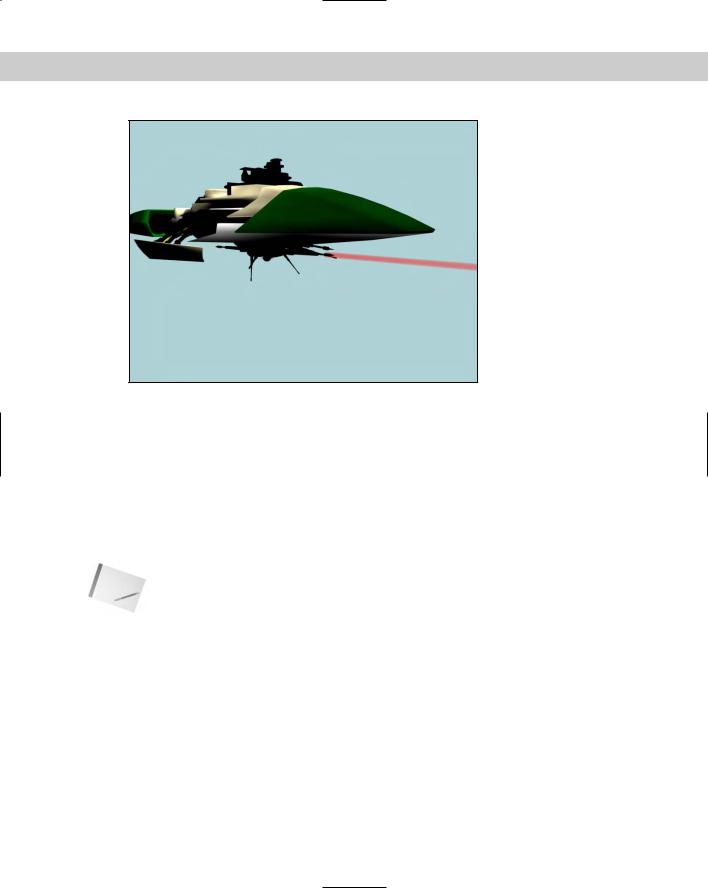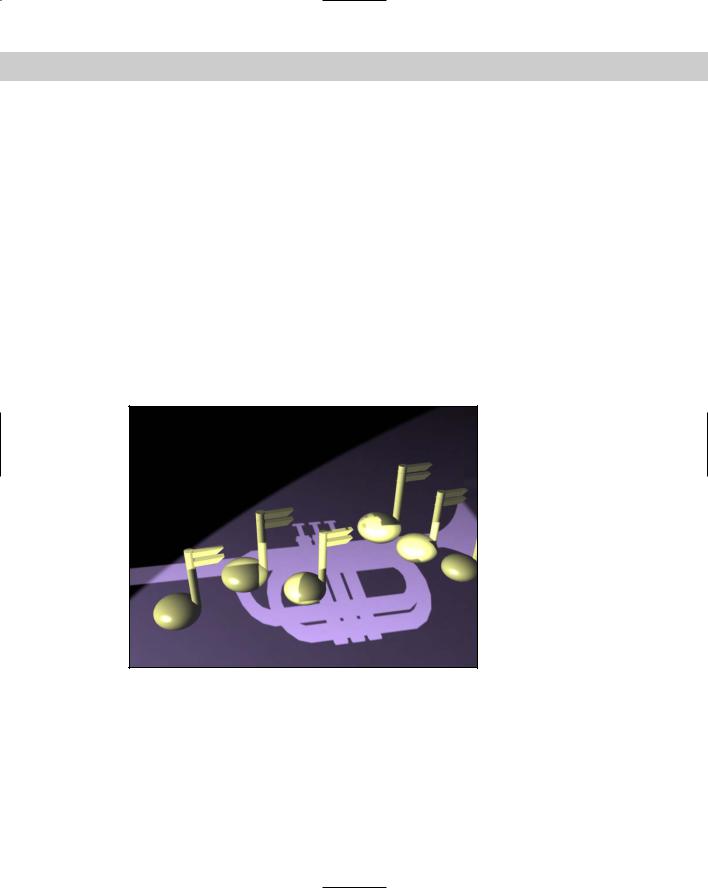
- •Preface
- •About This Book
- •Acknowledgments
- •Contents at a Glance
- •Contents
- •Relaxing at the Beach
- •Dressing the Scene
- •Animating Motion
- •Rendering the Final Animation
- •Summary
- •The Interface Elements
- •Using the Menus
- •Using the Toolbars
- •Using the Viewports
- •Using the Command Panel
- •Using the Lower Interface Bar Controls
- •Interacting with the Interface
- •Getting Help
- •Summary
- •Understanding 3D Space
- •Using the Viewport Navigation Controls
- •Configuring the Viewports
- •Working with Viewport Backgrounds
- •Summary
- •Working with Max Scene Files
- •Setting File Preferences
- •Importing and Exporting
- •Referencing External Objects
- •Using the File Utilities
- •Accessing File Information
- •Summary
- •Customizing Modify and Utility Panel Buttons
- •Working with Custom Interfaces
- •Configuring Paths
- •Selecting System Units
- •Setting Preferences
- •Summary
- •Creating Primitive Objects
- •Exploring the Primitive Object Types
- •Summary
- •Selecting Objects
- •Setting Object Properties
- •Hiding and Freezing Objects
- •Using Layers
- •Summary
- •Cloning Objects
- •Understanding Cloning Options
- •Mirroring Objects
- •Cloning over Time
- •Spacing Cloned Objects
- •Creating Arrays of Objects
- •Summary
- •Working with Groups
- •Building Assemblies
- •Building Links between Objects
- •Displaying Links and Hierarchies
- •Working with Linked Objects
- •Summary
- •Using the Schematic View Window
- •Working with Hierarchies
- •Setting Schematic View Preferences
- •Using List Views
- •Summary
- •Working with the Transformation Tools
- •Using Pivot Points
- •Using the Align Commands
- •Using Grids
- •Using Snap Options
- •Summary
- •Exploring the Modifier Stack
- •Exploring Modifier Types
- •Summary
- •Exploring the Modeling Types
- •Working with Subobjects
- •Modeling Helpers
- •Summary
- •Drawing in 2D
- •Editing Splines
- •Using Spline Modifiers
- •Summary
- •Creating Editable Mesh and Poly Objects
- •Editing Mesh Objects
- •Editing Poly Objects
- •Using Mesh Editing Modifiers
- •Summary
- •Introducing Patch Grids
- •Editing Patches
- •Using Modifiers on Patch Objects
- •Summary
- •Creating NURBS Curves and Surfaces
- •Editing NURBS
- •Working with NURBS
- •Summary
- •Morphing Objects
- •Creating Conform Objects
- •Creating a ShapeMerge Object
- •Creating a Terrain Object
- •Using the Mesher Object
- •Working with BlobMesh Objects
- •Creating a Scatter Object
- •Creating Connect Objects
- •Modeling with Boolean Objects
- •Creating a Loft Object
- •Summary
- •Understanding the Various Particle Systems
- •Creating a Particle System
- •Using the Spray and Snow Particle Systems
- •Using the Super Spray Particle System
- •Using the Blizzard Particle System
- •Using the PArray Particle System
- •Using the PCloud Particle System
- •Using Particle System Maps
- •Controlling Particles with Particle Flow
- •Summary
- •Understanding Material Properties
- •Working with the Material Editor
- •Using the Material/Map Browser
- •Using the Material/Map Navigator
- •Summary
- •Using the Standard Material
- •Using Shading Types
- •Accessing Other Parameters
- •Using External Tools
- •Summary
- •Using Compound Materials
- •Using Raytrace Materials
- •Using the Matte/Shadow Material
- •Using the DirectX 9 Shader
- •Applying Multiple Materials
- •Material Modifiers
- •Summary
- •Understanding Maps
- •Understanding Material Map Types
- •Using the Maps Rollout
- •Using the Map Path Utility
- •Using Map Instances
- •Summary
- •Mapping Modifiers
- •Using the Unwrap UVW modifier
- •Summary
- •Working with Cameras
- •Setting Camera Parameters
- •Summary
- •Using the Camera Tracker Utility
- •Summary
- •Using Multi-Pass Cameras
- •Creating Multi-Pass Camera Effects
- •Summary
- •Understanding the Basics of Lighting
- •Getting to Know the Light Types
- •Creating and Positioning Light Objects
- •Viewing a Scene from a Light
- •Altering Light Parameters
- •Working with Photometric Lights
- •Using the Sunlight and Daylight Systems
- •Using Volume Lights
- •Summary
- •Selecting Advanced Lighting
- •Using Local Advanced Lighting Settings
- •Tutorial: Excluding objects from light tracing
- •Summary
- •Understanding Radiosity
- •Using Local and Global Advanced Lighting Settings
- •Working with Advanced Lighting Materials
- •Using Lighting Analysis
- •Summary
- •Using the Time Controls
- •Working with Keys
- •Using the Track Bar
- •Viewing and Editing Key Values
- •Using the Motion Panel
- •Using Ghosting
- •Animating Objects
- •Working with Previews
- •Wiring Parameters
- •Animation Modifiers
- •Summary
- •Understanding Controller Types
- •Assigning Controllers
- •Setting Default Controllers
- •Examining the Various Controllers
- •Summary
- •Working with Expressions in Spinners
- •Understanding the Expression Controller Interface
- •Understanding Expression Elements
- •Using Expression Controllers
- •Summary
- •Learning the Track View Interface
- •Working with Keys
- •Editing Time
- •Editing Curves
- •Filtering Tracks
- •Working with Controllers
- •Synchronizing to a Sound Track
- •Summary
- •Understanding Your Character
- •Building Bodies
- •Summary
- •Building a Bones System
- •Using the Bone Tools
- •Using the Skin Modifier
- •Summary
- •Creating Characters
- •Working with Characters
- •Using Character Animation Techniques
- •Summary
- •Forward versus Inverse Kinematics
- •Creating an Inverse Kinematics System
- •Using the Various Inverse Kinematics Methods
- •Summary
- •Creating and Binding Space Warps
- •Understanding Space Warp Types
- •Combining Particle Systems with Space Warps
- •Summary
- •Understanding Dynamics
- •Using Dynamic Objects
- •Defining Dynamic Material Properties
- •Using Dynamic Space Warps
- •Using the Dynamics Utility
- •Using the Flex Modifier
- •Summary
- •Using reactor
- •Using reactor Collections
- •Creating reactor Objects
- •Calculating and Previewing a Simulation
- •Constraining Objects
- •reactor Troubleshooting
- •Summary
- •Understanding the Max Renderers
- •Previewing with ActiveShade
- •Render Parameters
- •Rendering Preferences
- •Creating VUE Files
- •Using the Rendered Frame Window
- •Using the RAM Player
- •Reviewing the Render Types
- •Using Command-Line Rendering
- •Creating Panoramic Images
- •Getting Printer Help
- •Creating an Environment
- •Summary
- •Creating Atmospheric Effects
- •Using the Fire Effect
- •Using the Fog Effect
- •Summary
- •Using Render Elements
- •Adding Render Effects
- •Creating Lens Effects
- •Using Other Render Effects
- •Summary
- •Using Raytrace Materials
- •Using a Raytrace Map
- •Enabling mental ray
- •Summary
- •Understanding Network Rendering
- •Network Requirements
- •Setting up a Network Rendering System
- •Starting the Network Rendering System
- •Configuring the Network Manager and Servers
- •Logging Errors
- •Using the Monitor
- •Setting up Batch Rendering
- •Summary
- •Compositing with Photoshop
- •Video Editing with Premiere
- •Video Compositing with After Effects
- •Introducing Combustion
- •Using Other Compositing Solutions
- •Summary
- •Completing Post-Production with the Video Post Interface
- •Working with Sequences
- •Adding and Editing Events
- •Working with Ranges
- •Working with Lens Effects Filters
- •Summary
- •What Is MAXScript?
- •MAXScript Tools
- •Setting MAXScript Preferences
- •Types of Scripts
- •Writing Your Own MAXScripts
- •Learning the Visual MAXScript Editor Interface
- •Laying Out a Rollout
- •Summary
- •Working with Plug-Ins
- •Locating Plug-Ins
- •Summary
- •Low-Res Modeling
- •Using Channels
- •Using Vertex Colors
- •Rendering to a Texture
- •Summary
- •Max and Architecture
- •Using AEC Objects
- •Using Architectural materials
- •Summary
- •Tutorial: Creating Icy Geometry with BlobMesh
- •Tutorial: Using Caustic Photons to Create a Disco Ball
- •Summary
- •mental ray Rendering System
- •Particle Flow
- •reactor 2.0
- •Schematic View
- •BlobMesh
- •Spline and Patch Features
- •Import and Export
- •Shell Modifier
- •Vertex Paint and Channel Info
- •Architectural Primitives and Materials
- •Minor Improvements
- •Choosing an Operating System
- •Hardware Requirements
- •Installing 3ds max 6
- •Authorizing the Software
- •Setting the Display Driver
- •Updating Max
- •Moving Max to Another Computer
- •Using Keyboard Shortcuts
- •Using the Hotkey Map
- •Main Interface Shortcuts
- •Dialog Box Shortcuts
- •Miscellaneous Shortcuts
- •System Requirements
- •Using the CDs with Windows
- •What’s on the CDs
- •Troubleshooting
- •Index

Chapter 27 Basic Lighting Techniques 705
Figure 27-14: Several frames of an animation showing a tree scene from sunrise to sunset
Using Volume Lights
When light shines through fog, smoke, or dust, the beam of the light becomes visible. The effect is known as a Volume Light. To add a Volume Light to a scene, choose Rendering Environment (or press the 8 key) to open the Environment dialog box. Then click the Add button in the Atmosphere rollout to open the Add Atmospheric Effect dialog box, and select Volume Light. The parameters for the volume light are presented in the Volume Light Parameters rollout.
You can also access the Volume Light effect from the Atmospheres and Effects rollout in the Modify panel when a light is selected.
Cross- |
Chapter 42, “Using Atmospheric Effects,” covers the other atmospheric effects. |
Reference |
|
Volume light parameters
At the top of the Volume Light Parameters rollout, shown in Figure 27-15, is a Pick Light button, which enables you to select a light to apply the effect to. You can select several lights, which then appear in a drop-down list. You can remove lights from this list with the Remove Light button.

706 Part VI Lighting
Figure 27-15: The Volume Light Parameters rollout in the Environment dialog box lets you choose which lights to include in the effect.
In the Volume section, the Fog Color swatch lets you select a color for the fog that is seen within the light. This color is combined with the color of the light. The Attenuation Color is the color the fog appears to have at a distance far from the light source. This color also combines with the Fog Color and is best set to a dark color.
The Density value determines the thickness of the fog. The Exponential option causes the density to increase exponentially with the distance. The Max and Min Light Percentage values determine the amount of glow that the volume light causes, and the Attenuation Multiplier controls the strength of the attenuation color.
You have four options for filtering shadows: Low, Medium, High, and Use Light Smp Range. The Low option renders shadows quickly but isn’t very accurate. The High option takes a while but produces the best quality. The Use Light Smp Range option bases the filtering on the Sample Volume value and can be set to Auto. The Sample Volume can range from 1 to 10,000. The Low option has a Sample Volume value of 8; Medium, 25; and High, 50.
The Start and End Attenuation values are percentages of the Start and End range values for the light’s attenuation. These values have an impact only if attenuation is turned on for the light.
The Noise settings help determine the randomness of Volume Light. Noise effects can be turned on and given an Amount. You can also Link the noise to the light instead of using world coordinates. Noise types include Regular, Fractal, and Turbulence. Another option inverts the noise pattern. The Noise Threshold limits the effect of noise. Wind settings affect how the light moves as determined by the wind’s direction, Wind Strength, and Phase.
Figure 27-16 shows several volume light possibilities. The left image includes the Volume Light effect, the middle image enables shadows, and the right image includes some Turbulent Noise.

Chapter 27 Basic Lighting Techniques 707
Figure 27-16: The Volume Light effect makes the light visible.
Tutorial: Showing car headlights
One popular way to use volume lights is to display the headlights of cars. For this tutorial, we’re going to use the Delfino Feroce 2001 car model created by Viewpoint Datalabs.
To display the headlights of a car, follow these steps:
1.Open the Car headlights.max file from the Chap 27 directory on the CD-ROM. This file includes a model of a car.
2.Select the Create Lights Standard Lights Target Spotlight menu command, and drag in the Left viewport to create a spotlight object. Select and move the spotlight and the target to be positioned to look as if a light is shining out from the left headlight.
3.Open the Modify panel, and in the Spotlight Parameters rollout, set the Hotspot value to 20 and the Falloff to 25. In the Atmospheres and Effects rollout, click the Add button, select Volume Light from the Add Atmosphere or Effect dialog box that appears, and click OK.
Note |
When a light is added to the scene, the default lights are automatically turned off. To provide |
|
any additional lighting, add some Omni lights above the car. |
4.Select the Volume Light effect in the list within the Atmospheres and Effects rollout, and click the Setup button. The Environment dialog box opens, in which you can edit the Volume Light parameters for the newly created light. Set the Density value to 100.
5.Now create three more headlights. To do this, select both the first spotlight object and its target, and create a cloned copy by holding down the Shift key while moving it toward the right headlight. Position the other spotlights so that they shine outward from the other headlights.
Figure 27-17 shows the resulting car with its headlights illuminated.

708 Part VI Lighting
Figure 27-17: The car now has headlights, thanks to spotlights and the Volume Light effect.
Tutorial: Creating laser beams
Laser beams are extremely useful lights. From your CD-ROM drive to your laser printer, lasers are found throughout a modern-day office. They also are great to use in fantasy and science fiction images. You can easily create laser beams using direct lights and the Volume Light effect. In this tutorial, we add some lasers to the spaceship model created by Viewpoint Datalabs.
To add some laser beams to a scene, follow these steps:
1.Open the Spaceship laser.max file from the Chap 27 directory on the CD-ROM. This file includes a spaceship model.
2.Select the Create Lights Standard Lights Directional menu command, and add a Free Direct light to the end of one of the laser guns in the Front viewport. Scale the light down until the cylinder is the size of the desired laser beam.
3.With the light selected, open the Modify panel. In the Atmospheres and Effects rollout, click the Add button and double-click the Volume Light selection. Then select the Volume Light option in the list, and click the Setup button to open the Environment dialog box. Change the Fog Color to red, and make sure that the Use Attenuation Color is disabled.
4.With the direct lights added to the scene, the default lights are deactivated, so you need to add some Omni lights above the spaceship to illuminate it. To do this, select the Create Lights Standard Lights Omni menu command, and click above the spaceship in the Front view three times to create three lights. Set the Multiplier on the first light to 1.0, and position it directly above the spaceship. Set the other two lights to 0.5, and position them on either side of the spaceship and lower than the first light.
Figure 27-18 shows the resulting laser beams shooting forth from the spaceship.

Chapter 27 Basic Lighting Techniques 709
Figure 27-18: You can create laser beams using direct lights and the
Volume Light effect.
Using projector maps and raytraced shadows
If a map is added to a light in the Parameters rollout, the light becomes a projector. Projector maps can be simple images, animated images, or black-and-white masks to cast shadows. To load a projector map, select a light and open the Modify panel. Under the Spotlight Parameters rollout, click the Projector Map button and select the map to use from the Material/Map Browser.
Raytraced shadows take longer to render than the Shadow Maps or Area Shadows option, but the shadows always have a hard edge and are an accurate representation of the object.
Note |
You can create shadows for wire-frame objects only by using raytraced shadows. |
In the Shadow Parameters rollout, you can select whether shadows are computed using shadow maps or raytraced shadows. Using the latter selection lets you project a transparent object’s color onto the shadow.
Tutorial: Projecting a trumpet image on a scene
As an example of a projector light, we create a musical scene with several musical notes and project the image of a trumpet on them.
To project an image onto a rendered scene, follow these steps:
1.Open the Trumpet mask.max file from the Chap 27 directory on the CD-ROM.
This file includes a trumpet model shown in the maximized Left viewport. This file is used to generate a project map.

710 Part VI Lighting
2.Choose Rendering Render (or press the F10 key) to open the Render dialog box; set the resolution to 640×480, and select the Left viewport. Then select the Render Elements tab, and click the Add button. Select Alpha from the Render Elements dialog box, click OK, and then click the Render button. The side view of the trumpet in the Rendered Frame Window renders along with an alpha channel rendering of the trumpet. When the rendering completes, click the Save File button in the Rendered Frame Window for the alpha channel and save the file as trumpet mask.tif.
3.Open the Musical notes.max file from the Chap 27 directory on the CD-ROM. This file contains several musical notes created from primitive objects.
4.Select the Create Lights Standard Lights Target Spotlight menu command, and drag to create two lights in the Top viewport. Position the first spotlight to be perpendicular to the scene and to shine down on it from above.
5.Open the Modify panel; in the Advanced Effects rollout, click the Projector Map button and double-click Bitmap from the Material/Map Browser. Locate and select the Trumpet Mask.tif file, and click Open. This projects a silhouette of a trumpet onto the scene. Use the second spotlight to light the music notes.
Figure 27-19 shows the musical notes with the trumpet projection map.
Figure 27-19: You can use Projection maps to project an image in the scene, like this trumpet.
Tutorial: Creating a stained-glass window
When a light that uses raytraced shadows shines through an object with transparent materials, the Filter color of the material is projected onto objects behind. In this tutorial, we create a stained-glass window and shine a light through it using raytraced shadows.

Chapter 27 Basic Lighting Techniques 711
To create a stained-glass window, follow these steps:
1.Open the Stained glass window.max file from the Chap 27 directory on the CD-ROM.
This file includes a stained-glass window for a fish market (don’t ask me why a fish market has a stained-glass window).
2.Select the Create Lights Standard Lights Target Spotlight menu command, and drag in the Left view from a position to the right and above the window to the window.
This creates a target spotlight that shines through the stained-glass window onto the floor behind it.
3.In the General Parameters rollout, make sure that the On option is enabled in the Shadows section and select Ray Traced Shadows from the drop-down list. In the Shadow Parameters rollout, enable the On option for Atmosphere Shadows.
Figure 27-20 shows the stained-glass window with the colored shadow cast on the scene floor.
Figure 27-20: A stained-glass window effect created with raytraced shadows
